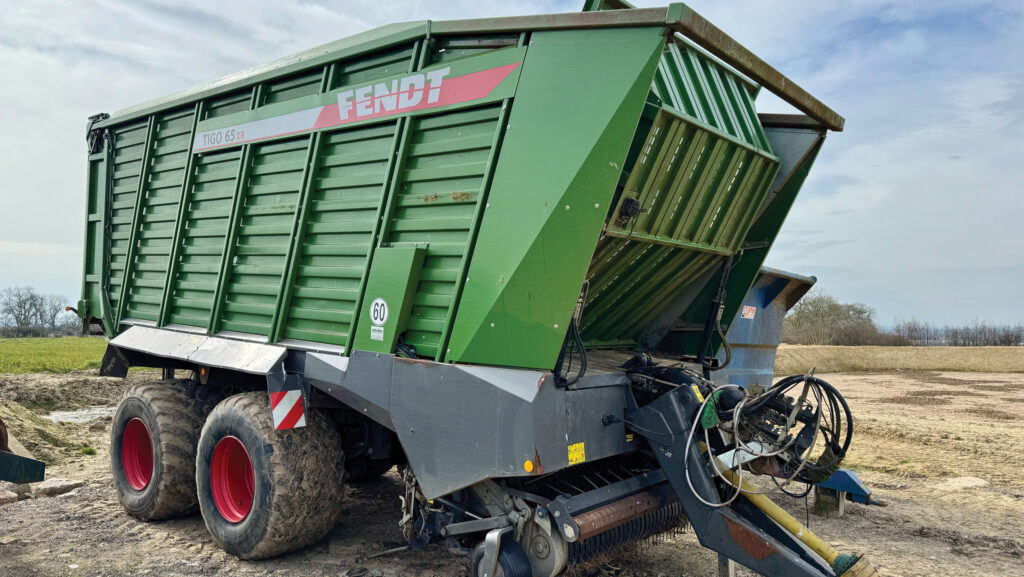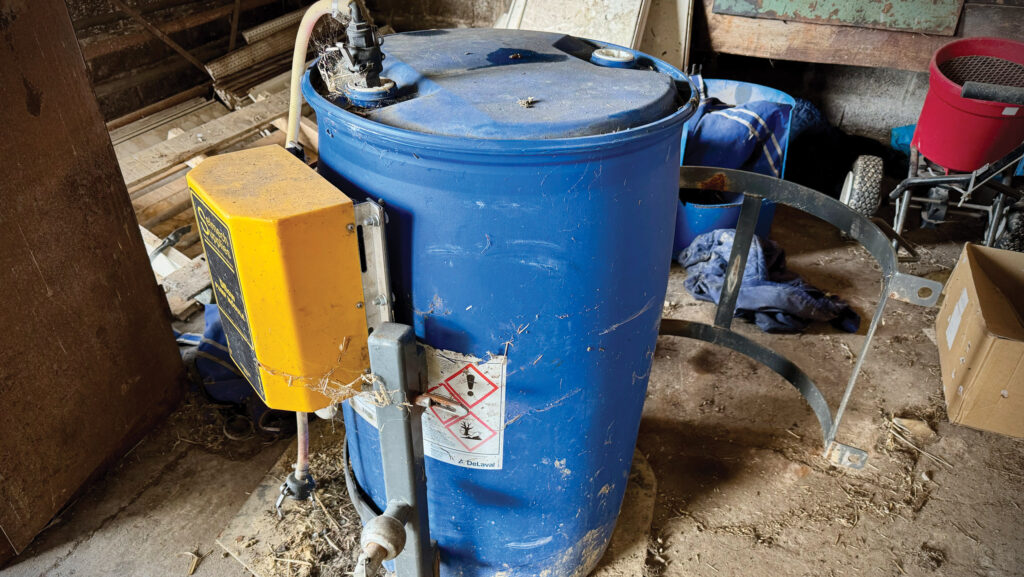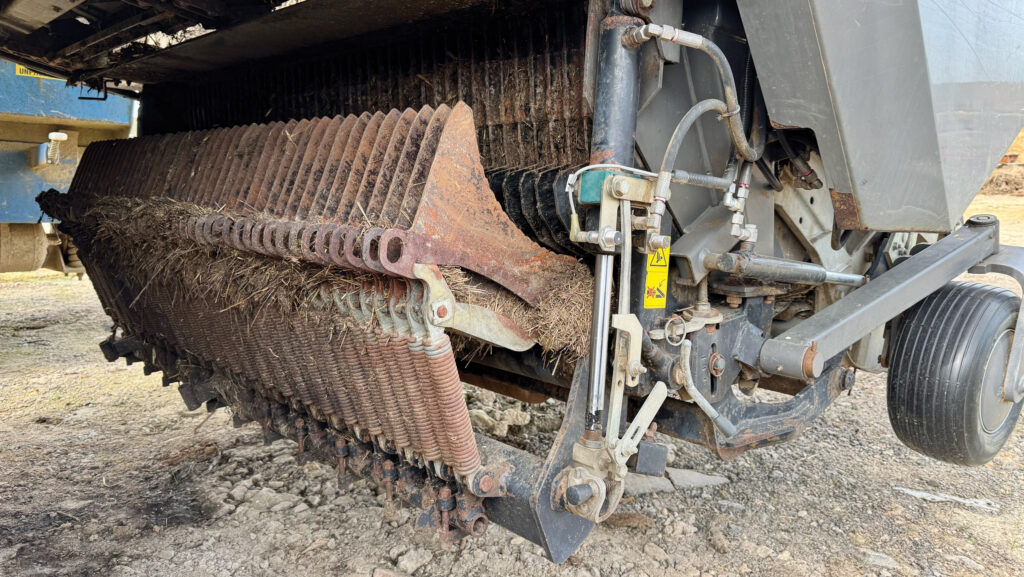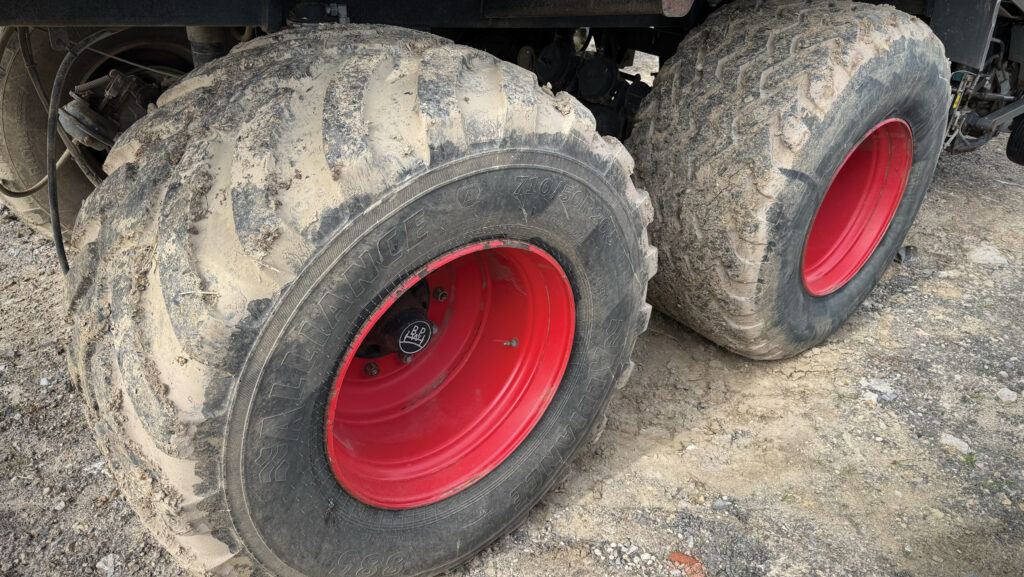Driver’s view: George Reed’s wide-body Fendt Tigo 65 XR
 © George Reed
© George Reed Agco completed a multimillion-pound deal for Lely’s forage machinery division in 2017, giving it access to a vast range of mowers, tedders, rakes, balers and forage wagons.
The latter have been sold in Fendt colours ever since, and the line-up titivated to accommodate three lower-spec PR models, two middling VRs and four high-capacity XRs.
However, these will soon be mothballed following the company’s announcement that it is to cease forage wagon production at its German factory.
See also: Driver’s view: JS Haddy’s John Deere C441R Maxicut
Somerset farmer George Reed was among the first in the South West to take one of these green-liveried wagons, an ex-demo Tigo 65 XR, in 2019.
It has been kept busy since, given the 280ha organic farm runs a multicut system on its 140ha of silage ground.
This feeds 300 milking cows and 400 head of youngstock and beef, supplemented by 80ha of arable ground used to grow fodder beet and wholecrop.

© MAG/Oliver Mark
Why a forage wagon?
We bought our first wagon, a 36cu m Kverneland Taarup 10055 R, 10 years ago.
It was mid-April and we had a contractor lined up to lift some young clover leys, but it had been a wet spring and I didn’t want their trailers on super-single tyres running all over the ground.
We managed to get the KV, which was on big 750s, on demo from a local dealer, picked up the crop, and never gave it back.
Fendt Tigo 65 XR
- Year 2019
- Capacity 38cu m
- Pick-up width 2m
- Knives 45
- Chop length 40mm
- Weight 9.2t
- Tyres 710/50 R26.5 Vredestein
- Price paid £75,000 as a one-year-old ex-demo in 2019
Since then, we’ve increased our first-cut area from 80ha to 120ha and, six years ago, brought in the Fendt Tigo.
We also get some help from a contractor with a couple of Pottinger wagons, which he charges out at about £130/hour each.
Running our two wagons is 50-60% cheaper than paying for a chopper, tractors and trailers to come out five times a year, even once we’ve accounted for the cost of finance, staff and fuel.
And the great thing about having a pair of them is that we can keep ticking off the acres and filling up the pit if one breaks down, unlike with a self-propelled forager.

© MAG/Oliver Mark
And why a Fendt Tigo XR?
We chose it mainly because Redlynch, our local dealer, had one available for demo.
It came out in 2019 and, like the KV, never went back. It runs rings around the KV, as it has a wider pick-up and the wide XR body can carry a serious amount of grass.
Basically, bigger is better, as it minimises the number of hauls per tonne and makes us far more efficient.
By my reckoning, running three wagons (including the contractor’s machine) is the equivalent of five trailers in terms of grass volume arriving at the clamp; 16t loads certainly keep the pit man busy.
The Tigo also has the bonus of tractor implement management (TIM), which allows the wagon to control the speed of the 724 based on crop flow.
Any extras?
It was ex-demo and well specced, with weigh cells, a pivoting headboard, vari-speed unloading and a rear camera.
We’ve since added an additive system that goes on the tractor’s front linkage, as there wasn’t much space to mount it on the wagon.

© MAG/Oliver Mark
The 200-litre barrel sits on a frame between the arms, so it only sticks out 6in beyond them, with a pipe running down the side of the tractor to the knife bank.
How much work does it do?
We run a 32-day multicut system, so the wagons go out five or six times a year.
First-cut tends to be 120-140ha, and we lose about 8ha to grazing with every subsequent cut. By the fourth, we’re usually clearing 90-100ha.
We try to stick rigidly to the 32-day cycle. I’m a gambler, so if there’s a small weather window then I’ll go for it – no matter whether the crop is 2t, 6t or 9t/acre.
There’s no guarantee that the grass will improve by waiting, and it means we can get the slurry on and give it another lease of life.
Buying a second-hand four-rotor rake has made us far more efficient, as we can load the wagons twice as quickly and leave half the number of wheelings.
How has it performed?
We’ve been really pleased with it, but you need a competent operator in the seat to really maximise efficiency.
I spend 95% of my time looking at the pick-up and, to get as much grass in as possible, I tend to load manually.
I only move the bed back once the tractor starts to labour. It means we’re dealing with some pretty big loads.
The Fendt 724 handles it but there are times where we need to be starting the load going uphill and finishing on a downhill run.
An 828 would be a better bet in terms of power and weight, but it would drink a lot more than the 724’s 42 litres/hour average.
Either way, a stepless transmission is critical to keep the pto at a constant 1,000rpm – even if you end up sacrificing forward speed.
We tend to use the Tigo for all the headlands because of its wider pick-up.
I can count on one hand how many times it’s blocked up in five years; unlike the KV, which tries to squeeze the grass through too small a gap.
It’s also surprisingly stable – except when you forget to put the steering axle in its locked position on the road – and it’ll swing into a 20ft gateway from a single-track road.

© MAG/Oliver Mark
But, with the axles far further forwards than a silage trailer and having the rear-steering system, the tail swing does take some getting used to.
The mudguards on ours have hit a few gateposts.
The only notable breakdowns have been a few pick-up drive chains.
I also had to buy a new door (£5,000) after bending it trying to eject a massive ball of old, fluffy grass on a cut-and-dump job for somebody else.
What’s grass quality like?
The 45 knives give a 40mm chop length, which is similar to the KV (narrower pick-up, 35 knives) but far more consistent.
It works well for us, and we have no problems with pit consolidation.

© MAG/Oliver Mark
It doesn’t need to look like a billiard table across the top as long as it has been rolled thoroughly, and we always use additive given we have a lot of clover, lucerne and high-protein grass.
In my view, there’s only one person that benefits from short-chop silage, and that’s the man on the pit.
The cows don’t care how long it is and rumination is better with the longer chop length.
We very rarely get displaced abomasums anymore, and there’s less effluent leaching from the clamp as the sugars are being retained in the grass. Our silage analysis often comes in at over 12ME.
What could be improved?
Our most common problems are broken pto guards. The shaft is mounted fairly high and it’s sometimes hard to keep the link arms out of harm’s way without removing them.
Ideally, I’d like a second roller on the intake. Having just the one is fine in heavy crops, but in lighter stuff it occasionally gets flicked by the grass in front and starts spinning the wrong way.
Once it has started doing that it’s very hard to get it to reverse.
And I’d also change the tyres.
The Vredestein Flotation Pro 710/50 R26.5s it came on are too rounded on the shoulders, cut the ground more than necessary, and don’t grip that well on the side of a hill.

© MAG/Oliver Mark
After finding a split in one, we replaced it with an Alliance 885, which is far better for both traction and flotation.
Other than that, the only issues have been sensor related. We’ve replaced a total of four on the rear door and knife bank.
Would you buy another?
We would if we had the time and staff to continue making our own silage. But we’re going to switch back to using a contractor with a John Deere chopper.
The main reason is to avoid the stress.
Our focus is milking cows, so it’s a real stretch for us to be mowing until the early hours, then be back yard scraping and milking at 5.30am, and out again soon after to pick up the grass.
Sheeting down the clamp also tends to be a problem.
We simply don’t have enough bodies to throw tyres and that’s our main – in fact, only – source of wastage. There are only so many hours in the day.
We’ll continue to do all the mowing and raking, and, in the short term at least, we’ll keep the Tigo.
That way, the contractor can deal with the big cuts and we can save a bit of money by doing some of the lighter crops ourselves.
It’s also a handy back-up in case anything goes wrong with the chopper.
There’s something very appealing about making silaging someone else’s problem – whether it’s staff, weather or breakdowns.
Likes and gripes
Likes
- Consistent chop length
- Wide pick-up
- Very stable
- Rarely blocks up
Gripes
- Roller reverses in light crops
- Link arms clash with pto shaft guard
- Curved shoulders of Vredestein tyres
- Sensors occasionally play up

